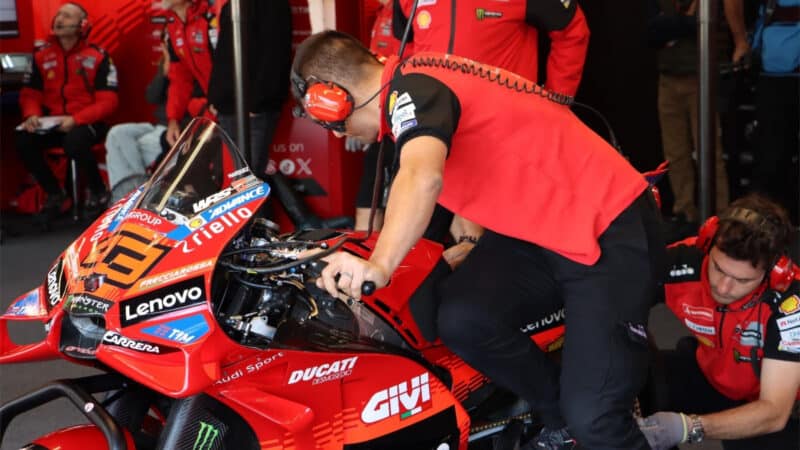“In some situations it’s difficult to manage but then you get used to everything and then everything becomes automatic,” adds Márquez. “But it can still be tricky, especially when you are trying to make your rhythm in a race, because if you’re not fully concentrated you can miss some buttons, because all the lap you are touching other things. It’s true that now we have even more, but we are developing a new system for the future.”
The Ducati’s front holeshot device is based on a concept first used many years ago in motocross. It’s a straightforward mechanical gadget, which locks the forks at full compression when the rider squeezes the forks as he rolls towards the grid.
The rear holeshot device is anything but straightforward. When MotoGP’s rule makers banned electronic/active suspension in the 1990s they assumed they’d banned electronic/active suspension but they didn’t consider the ingenuity of Dall’Igna and theoretical physicist Dr Robin Tuluie. Tuluie built his first hydraulic ride-height regulator for Mercedes in Formula 1, where electronic suspension is also banned. It used a hydraulic computer of 2000 parts – valves, accumulators and lots of cables and high-pressure hydraulic hoses.
Tuluie then built a smaller version for Ducati. The unit allows the rider to pull a lever to pump down the rear shock for starts, or flick a switch to compress the shock for corner exits.
Both holeshot devices and the ride-height adjuster lower the motorcycle, transforming it into a drag bike, so it wheelies less, thereby allowing the rider to use more throttle.
This is what we do know (and what we’re guessing when we don’t) about the 11 levers, buttons, switches and knobs.
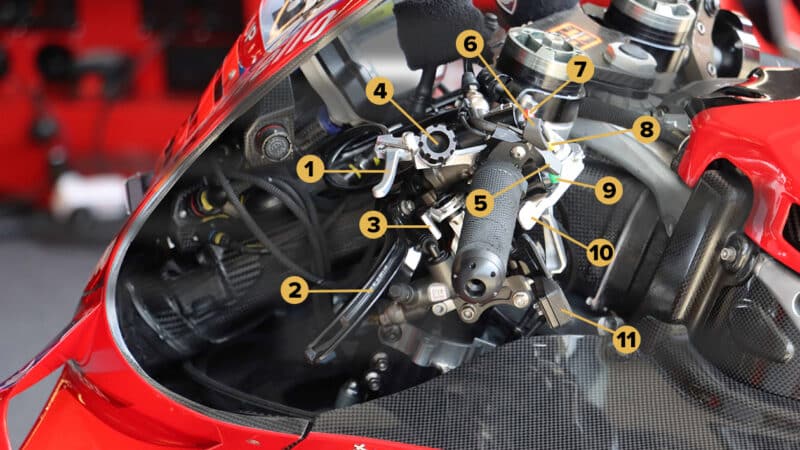
The left handlebar on Marquez’s Ducati GP25 is heavily populated with controls. Read below to see which does what
Oxley
1. A new holeshot lever introduced at Le Mans, where riders don’t brake aggressively for the French circuit’s sweeping first corner, so there’s always the chance the holeshot devices won’t disengage. If this happens the rider won’t be able to ride properly until he disengages them while braking hard for the next corner.
This lever works both holeshot devices, compressing the rear shock and allowing the rider to lock the forks at full compression. I’ve watched mechanics working on Marquez’s bikes, pulling this lever and compressing the bike’s rear end.
Third GP25 rider Fabio Di Giannantonio also uses the new lever, but Márquez’s factory Ducati team-mate Pecco Bagnaia has stuck with the existing rear holeshot activator, a kind of wingnut above the electronics switchgear.
2. Clutch lever. All being well, the rider only uses the clutch at the start and when he comes to a stop.
3. Holeshot control. Márquez operates this lever when he comes to a halt before a start, after he’s squatted the rear end and locked down the front forks. Also, this control seems to be in the path of the clutch lever, so when he opens the clutch before the start the lever also operates the holeshot control. Does this somehow help the front holeshot device or both holeshot devices to disengage?
4. Front brake lever control. This knob adjusts the span of the front brake lever, which riders during the race to keep their preferred span which changes according to brake temperature, brake wear and so on.
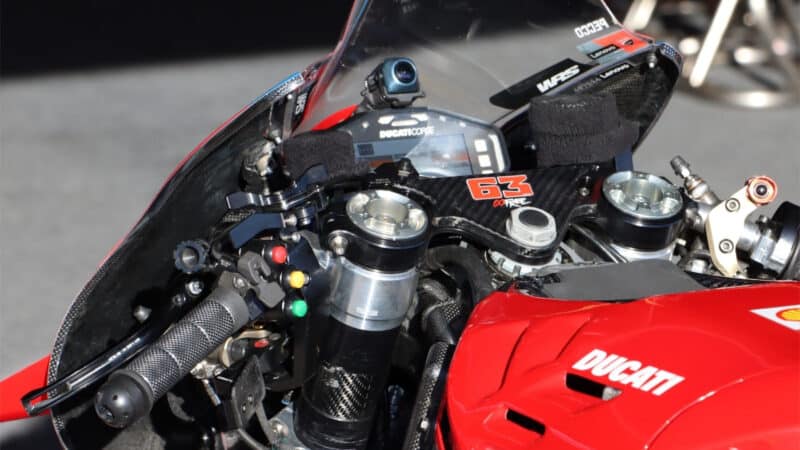
Bagnaia continues to use the wingnut-type holeshot engager to the left of the fork tops. Note the kill switch on the right handlebar, guarded by a surround, to prevent the rider hitting it by mistake
Matt Oxley
5. Ride-height adjuster, on switch. This part is borrowed from a mountain bike ride-height system. The rider presses this to manually compress the rear end to lower the centre of mass while exiting corners. Basically, the idea is to turn a MotoGP bike into a drag bike, until the next corner. There are also automatic activators to do this job in some situations.
6. Ride-height adjuster, off switch. This disengages the rear ride-height device, via cables and hydraulics, to lift the rear end to its usual position. There are also automatic activators to do this job in some situations.
7, 8 and 9. Red, yellow and green rider controls buttons – colours according to rider’s choosing. One button for traction control, one for torque delivery and one for engine-braking control. The rider presses the buttons to flip through three maps on each to choose more or less, according to grip conditions, tyre wear and so on. For example, when the rider has less grip towards the end of a race he may want to reduce engine braking, to prevent the rear tyre locking and skidding too much on the way into corners.
10. Ride-height lever. This lever may allow the rider to request the rear shock to squat in advance – useful because he’s already as busy as can be while riding through corners.
11. Rear brake lever, operated by left thumb. Most MotoGP riders use thumb rear brakes, because when they’re leaning into corners there’s no room to get their right feet to the traditional lever. Some have a two-way system, with thumb and right-foot levers, allowing them to use either, according to the situation. Riders don’t only use the rear brake to help stop the bike, they also use it to help the bike turn and to reduce wheelspin.
Although five of these controls will be gone at the end of 2026, there’s little doubt that Dall’Igna and other engineers will be thinking of new devices that will find their way through MotoGP’s major rules rewrite for 2027.
Dall’Igna got the idea for the ride-height adjuster soon after equipped his Desmosedicis with a rear holeshot device in 2018. In June 2019, factory Ducati rider Andrea Dovizioso drove an Audi in an Italian round of the DTM car championship, which got Dall’Igna thinking…
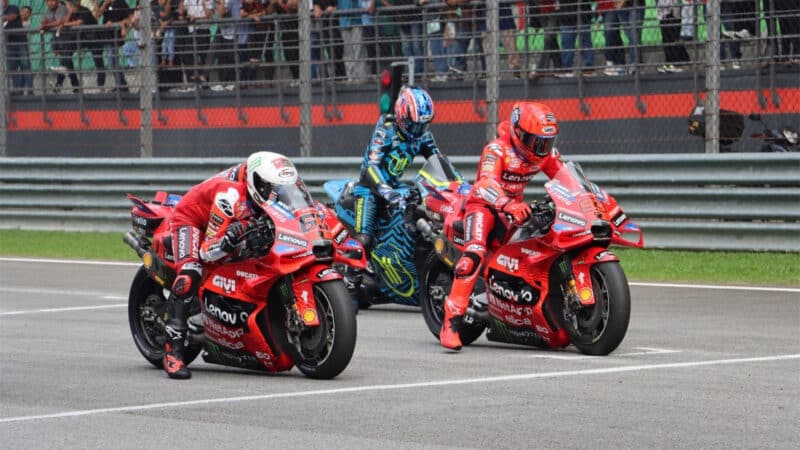
Bagnaia and Márquez locking and loading their Desmosedicis for practice starts during February’s pre-season tests at Sepang
Mat Oxley
“We were talking about the race and Andrea told me he had to flick a switch that sprayed water to cool the brakes,” Dall’Igna told me a few years ago. “I thought that if a car driver can flick a switch during the race, why not a motorcycle rider? From this, I started thinking about a system that the rider could use to lower the motorcycle, not only at the start but also during races.”
The irony of 21st-century MotoGP bikes featuring so many controls is that racing motorcycles were similarly equipped a century or so earlier: throttle, clutch lever, decompression lever, air/mixture levers, ignition advance-and-retard lever, oil pump, gear selection (often by hand), brake levers and so on.
This is PJ Wallace recalling the frantic and complex procedure of racing a Rudge 500cc single around Brooklands (the world’s first purpose-built racetrack, opened in 1907) shortly before the outbreak of the First World War.
“I was already familiar with the starting procedure,” wrote Wallace. “With the exhaust valve lever lifted, you pushed the machine, running alongside it until, at the right moment you dropped the lever and, as the engine bursts into life, you leap into the saddle. On the start-line, positioned near the middle of thirty or forty other competitors spaced across the whole hundred-foot width of the track, I tensely awaited the signal to start.
“At last the flag dropped and the scene was transformed. Three dozen young men were heaving their heavy machines forward and running as fast as they could go. There was bedlam. First a few, one after the other, then the whole mass of engines burst into life. As the riders leapt into their saddles, motorcycle swerved dangerously close to one another. As my own engine sprang into life the chap on the right swerved in front, missing my wheel by inches as he made for the inside of the track.
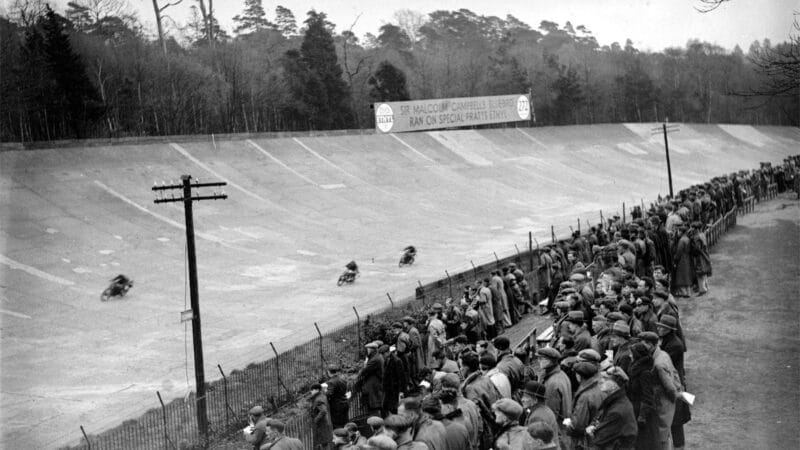
Motorcycles race around the banking at Brooklands
Stilltime
“My machine bucketed about in the most unexpected manner and it needed every effort to keep it on a straight course. The difficulties were accentuated by the need to juggle the pair of levers controlling the carburettor. Then there was the ignition advance-and-retard lever which was on the side of the tank, about which my knees were tightly gripped anyway.”
And then there was the oil pump. “Failure in its proper operation could result in engine seizure, causing a serious skid or even the rider being thrown over the handlebars. At touring speeds, one pump-full every ten miles would normally be sufficient. At racing speeds, very much more because so much oil was being thrown out of the exhaust. Operation of the pump meant taking one’s hand off the handlebars; not too bad if the pump returned with the action of a spring. The more common type with a two-way cock was a nightmare, needing four consecutive operations taking twenty seconds. Hitting one of the bad bumps with one hand off the handlebars was a combination of events to be avoided…”

